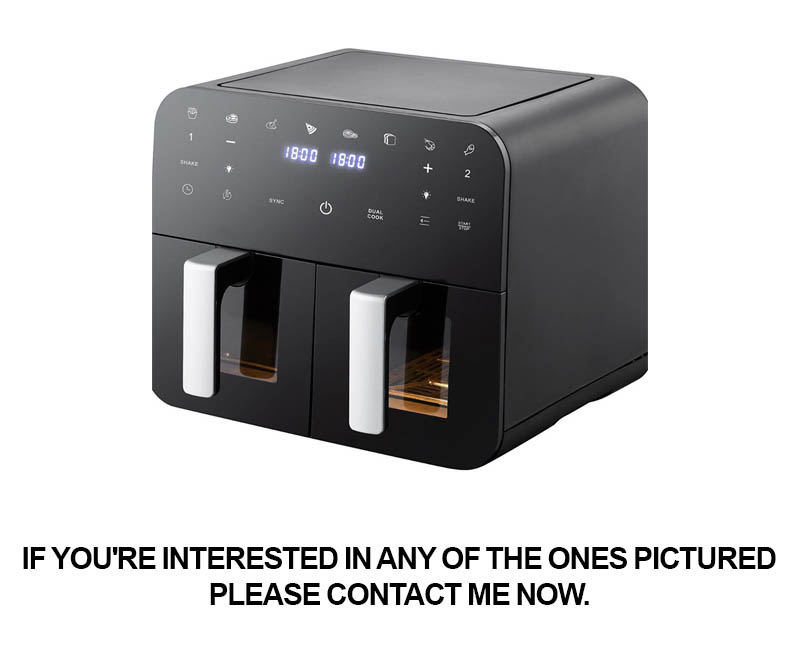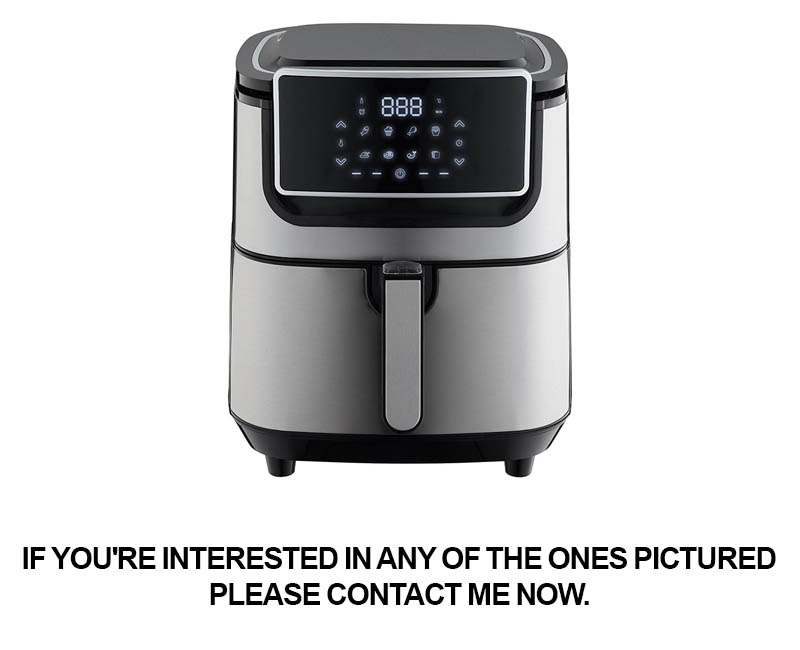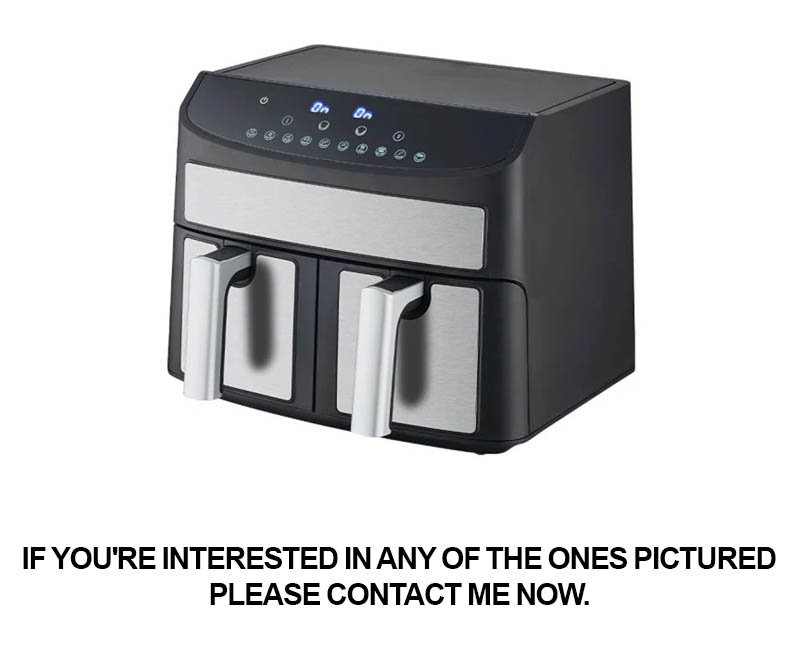Address
304 North Cardinal
St. Dorchester Center, MA 02124
Work Hours
Monday to Friday: 7AM - 7PM
Weekend: 10AM - 5PM
Address
304 North Cardinal
St. Dorchester Center, MA 02124
Work Hours
Monday to Friday: 7AM - 7PM
Weekend: 10AM - 5PM

In the ever-evolving landscape of kitchen appliances, one product has been making waves: the high capacity air fryer. This innovative kitchen gadget has not only transformed the way we cook but has also opened up new avenues for manufacturers looking to capitalize on a burgeoning market. With its ability to cook a variety of foods with minimal oil, the high capacity air fryer has become a staple in many households. Let’s delve into the factors that have propelled this product to the forefront and explore the opportunities and challenges that lie ahead.
The market has seen a remarkable surge in the popularity of high capacity air fryer factories. As health-conscious consumers continue to seek out healthier cooking alternatives, these factories have emerged as key players in the kitchen appliances sector. The demand for high capacity air fryers has skyrocketed, driven by their ability to cook larger portions and their versatility in preparing a wide range of foods.
These factories have invested heavily in technology and innovation to meet the growing demand. Their production lines are equipped with state-of-the-art machinery that ensures high efficiency and quality control. The result is a product that not only meets consumer expectations but also stands out in terms of performance and durability.
Consumers are increasingly drawn to the convenience and health benefits that high capacity air fryers offer. They provide a healthier alternative to deep-frying, reducing the amount of oil needed and, consequently, the calorie content of the food. This has become a major selling point for these factories, as health trends continue to influence purchasing decisions.
As the demand for high capacity air fryers has intensified, these factories have expanded their product lines to cater to different market segments. From residential models to commercial versions for restaurants and caterers, the diversity in their offerings has allowed them to capture a broader customer base. This strategic diversification has proven to be a pivotal factor in their success.
The rise of e-commerce has also played a significant role in the growth of high capacity air fryer factories. With more consumers turning to online shopping, these factories have leveraged digital platforms to reach a wider audience. Their websites and online stores are optimized for easy navigation and seamless purchasing experiences, making it convenient for customers to browse and buy their products.
Supply chain management has become crucial for these factories, as they strive to maintain inventory levels to meet the high demand. Efficient logistics and distribution networks ensure that products are delivered to retailers and customers promptly. This focus on supply chain efficiency has helped these factories to maintain a competitive edge in the market.
The environmental consciousness of consumers has not gone unnoticed by these factories. Many have started to incorporate sustainable practices into their operations, such as using energy-efficient machinery and reducing waste. This commitment to sustainability resonates with eco-conscious buyers and enhances the brand reputation of these factories.
Innovation remains at the core of these factories’ operations. Continuous research and development efforts have led to the creation of air fryers with unique features, such as adjustable temperature controls, automatic shut-off functions, and smart technology integration. These innovations not only improve the cooking experience but also differentiate the products in a crowded market.
Despite the rapid growth, these factories face challenges. The competitive landscape is fierce, with numerous brands vying for market share. Additionally, the rapid pace of technological advancements requires constant investment in research and development to stay ahead of the curve.
Looking ahead, the future of high capacity air fryer factories is bright. The health and wellness trend is expected to continue, fueling demand for these appliances. Furthermore, as technology evolves, these factories will have the opportunity to introduce even more advanced features and functionalities to their products.
In conclusion, the rise of high capacity air fryer factories is a testament to the power of innovation, market trends, and consumer preferences. By adapting to the needs of the market and continuously pushing the boundaries of what air fryers can do, these factories have positioned themselves as leaders in the kitchen appliances industry.

The air fryer market has seen a remarkable transformation, driven by shifting consumer preferences and a growing demand for healthier cooking options. As the health consciousness of consumers continues to rise, the demand for high-capacity air fryer factories has surged. These appliances offer a healthier alternative to traditional deep-frying, allowing users to enjoy crispy, golden-brown results without the excess fat.
Gone are the days when air fryers were considered a niche product; they have now become a staple in modern kitchens. The demand for these appliances has been further fueled by the convenience they offer, as they can cook a variety of foods with minimal effort and time. This dual appeal of health and convenience has made high-capacity air fryers a must-have item for many consumers.
The market dynamics are also shaped by the rise of e-commerce platforms. Online shopping has made it easier for consumers to discover and purchase air fryers, regardless of their location. This has opened up new markets and expanded the reach of high-capacity air fryer factories. Moreover, the competitive pricing and frequent promotions on these platforms have encouraged more consumers to make the switch from traditional cooking methods to air frying.
In response to the increasing demand, manufacturers have been quick to innovate. They are now producing air fryers with larger capacities, allowing families and individuals to cook larger batches of food in one go. This is particularly appealing to busy households that need to prepare meals for multiple people at once. The introduction of multi-functional air fryers, which can also bake, roast, and dehydrate, has also added to the market’s allure.
The demand for high-capacity air fryers is not limited to individual consumers; restaurants and commercial kitchens are also increasingly adopting these appliances. The commercial air fryers are designed to handle the volume of food required for a busy restaurant, offering a more efficient way to cook fried foods with less oil. This shift towards healthier cooking methods in commercial settings is not only beneficial for the health of customers but also for the environmental impact of foodservice operations.
Another driving factor in the market dynamics is the growing awareness of the health risks associated with excessive oil consumption. With the rise of heart disease and obesity rates, consumers are looking for healthier alternatives to traditional frying. High-capacity air fryers have stepped into this gap, providing a solution that satisfies the craving for fried foods without the health drawbacks.
The demand for these appliances is also influenced by the availability of a wide range of recipes and cooking guides. Social media, cooking blogs, and recipe apps have become go-to sources for inspiration, encouraging consumers to experiment with their air fryers. The versatility of air fryers has made them a favorite among food enthusiasts, leading to a continuous cycle of innovation and demand.
The market for high-capacity air fryers is also being influenced by demographic changes. As the global population ages, there is a growing segment of health-conscious consumers who are more likely to invest in kitchen appliances that promote a healthy lifestyle. This demographic trend is expected to continue, further boosting the demand for air fryers with larger capacities.
In conclusion, the market dynamics and demand for high-capacity air fryers are shaped by a combination of health-conscious consumers, the convenience of e-commerce, innovation in product design, and the need for healthier cooking solutions. As these factors continue to evolve, the demand for high-capacity air fryer factories is poised to grow, driving the industry forward.

In the competitive landscape of the kitchen appliance industry, reaching a monthly revenue milestone of 20k is a significant achievement. This benchmark represents not just financial success but also a testament to the market’s acceptance and demand for high-quality products. Let’s delve into the factors that contribute to this impressive revenue figure.
The surge in popularity of high-capacity air fryers has been a game-changer for many manufacturers. These appliances have quickly become a staple in modern kitchens, driven by health-conscious consumers seeking a healthier alternative to traditional frying methods. The increased demand for these units has propelled sales, often exceeding expectations.
To hit the 20k/month revenue mark, manufacturers must focus on efficient production and supply chain management. Streamlining operations to reduce costs and minimize waste is crucial. By optimizing the production process, factories can produce more units in less time, ensuring a steady supply to meet the market’s demand.
The pricing strategy plays a pivotal role in maintaining a high revenue stream. Offering competitive prices while ensuring the quality of the product is top-notch is a delicate balance. Factories that have managed to do this effectively have seen their customer base grow, leading to consistent sales figures.
Marketing and branding also contribute significantly to the 20k/month revenue milestone. Creating a strong brand identity and leveraging social media and online platforms to reach a wider audience is essential. Consumers are more likely to purchase from brands they trust and recognize, making effective marketing a cornerstone of success.
Customer loyalty is another key element. By providing exceptional customer service and offering after-sales support, manufacturers can foster long-term relationships with their customers. Repeat purchases and positive word-of-mouth referrals can significantly boost monthly revenue.
Innovation in product design and features has become increasingly important. High-capacity air fryers that come with additional functions, such as programmable settings or the ability to cook a variety of dishes, often command higher prices and attract more customers. The ability to offer something unique in a crowded market can be a significant revenue driver.
The global nature of the market has also opened up opportunities for revenue growth. Factories that have successfully expanded their reach internationally have seen their revenue soar. Adapting products to meet the specific needs and preferences of different regions is crucial for this expansion.
Moreover, partnerships with retail giants and online marketplaces have been instrumental in achieving this revenue milestone. These partnerships provide access to a vast customer base and increase brand visibility. The convenience of online shopping has also made it easier for consumers to purchase high-capacity air fryers, contributing to the overall revenue.
Lastly, the economic climate and consumer spending patterns have a direct impact on revenue. During times of economic growth, consumers are more willing to invest in premium kitchen appliances. Conversely, during economic downturns, price sensitivity may increase, requiring strategic pricing adjustments.
In summary, the 20k/month revenue milestone for high-capacity air fryer factories is the result of a combination of factors, including market demand, efficient production, strategic pricing, effective marketing, customer loyalty, innovation, global expansion, partnerships, and economic conditions. By carefully navigating these elements, manufacturers can not only maintain this revenue level but also aim for continued growth in the competitive kitchen appliance market.

The landscape of high capacity air fryers is continually evolving, with manufacturers pushing the boundaries of what these kitchen appliances can offer. Here’s a look at some of the latest innovations shaping the market:
Smart Technology IntegrationModern high capacity air fryers are not just about cooking; they’re becoming smart kitchen companions. With features like Bluetooth connectivity, these appliances can sync with your smartphone, allowing you to control cooking times, temperatures, and even monitor the progress of your meal remotely.
Enhanced Cooking PerformanceInnovations in the cooking chamber design have led to improved performance. Newer models feature advanced airflow systems that ensure even cooking and crispiness, reducing the risk of unevenly cooked food. Some models also include programmable settings for different types of cuisine, making them versatile kitchen tools.
Energy EfficiencyEnergy consumption has always been a concern for consumers and manufacturers alike. Innovations in insulation and heating elements have significantly reduced the energy footprint of high capacity air fryers. These appliances are now more energy-efficient than ever, which not only saves money on electricity bills but also contributes to a greener planet.
Safety FeaturesSafety is paramount in kitchen appliances, and high capacity air fryers are no exception. New safety features include automatic shut-off mechanisms that activate when the fryer is left unattended or when the cooking chamber reaches unsafe temperatures. Some models also come with cool-touch surfaces and child lock features to prevent accidents.
Customizable Cooking SettingsToday’s high capacity air fryers offer a level of customization that was once reserved for professional kitchens. Users can adjust the cooking time and temperature with precision, allowing for everything from delicate seafood to hearty meats to be cooked to perfection. Some models even have pre-programmed recipes that take the guesswork out of cooking.
Compact and Space-Saving DesignsDespite their high capacity, these air fryers are designed to be space-efficient. Many models now feature sleek, compact designs that can fit into smaller kitchens or be stored away easily. Some even come with foldable legs or removable cooking baskets, making them versatile and easy to store.
Healthier Cooking OptionsOne of the biggest draws of air fryers is their ability to cook food with less oil than traditional frying methods. Innovations in the cooking process, such as using a high-speed fan to circulate hot air, have made it possible to create delicious, crispy foods that are healthier and lower in fat.
Noisy OperationsNoise levels have been a concern for some users, but advancements in the fan technology have significantly reduced the noise emitted by high capacity air fryers. These appliances are now quieter, making them more suitable for use in living spaces without causing disturbance.
Eco-Friendly MaterialsManufacturers are increasingly using eco-friendly materials in the construction of high capacity air fryers. From recyclable plastics to BPA-free components, these appliances are not only functional but also environmentally responsible.
Multi-Functional AppliancesThe latest high capacity air fryers are not just for frying. Many now come with additional features such as dehydrator settings, which allow users to dry fruits and herbs, and broiler capabilities for toasting or grilling. These multi-functional appliances offer a wider range of cooking options in one unit.
These innovations are not only making high capacity air fryers more user-friendly and efficient but also more appealing to health-conscious consumers who are looking for a way to enjoy their favorite fried foods with a healthier twist. As technology continues to advance, it’s exciting to think about what the next wave of innovations will bring to the air fryer market.

In the ever-evolving landscape of the kitchen appliances industry, staying ahead of the curve is paramount. Data and industry insights play a crucial role in shaping strategies and informing decisions. Here’s a delve into the key takeaways from recent market analysis:
1. Consumer Behavior ShiftsThe rise of health-conscious consumers has been a game-changer. Data shows a significant increase in the demand for appliances that offer healthier cooking options, like air fryers. Consumers are not just looking for convenience but also for products that align with their wellness goals.
2. Smart Technology IntegrationSmart kitchen appliances are becoming increasingly popular. The integration of IoT (Internet of Things) technology allows for remote control, data tracking, and even predictive maintenance. This shift is driven by the desire for more connected, efficient, and user-friendly devices.
3. Market SegmentationSegmentation analysis reveals distinct groups within the consumer base. For instance, families with young children are more likely to invest in appliances with safety features, while eco-conscious consumers are drawn to energy-efficient models. Understanding these segments helps manufacturers tailor their products to meet specific needs.
4. Global Market TrendsGlobal trends show that while the US and Europe remain significant markets for kitchen appliances, there’s a growing interest in emerging markets. Countries like China, India, and Brazil are seeing an upsurge in the adoption of modern kitchen appliances, driven by economic growth and urbanization.
5. E-commerce InfluenceThe rise of e-commerce has had a profound impact on the kitchen appliances market. Online sales now account for a significant portion of total sales, with consumers preferring the convenience of shopping from home. This trend has spurred manufacturers to focus on online marketing and e-commerce capabilities.
6. Sustainability and Eco-Friendly PracticesSustainability is no longer just a buzzword; it’s a critical factor in the appliance industry. Consumers are increasingly looking for appliances that are energy-efficient, made with sustainable materials, and have a lower environmental footprint. Data indicates a direct correlation between eco-friendly features and consumer purchasing decisions.
7. Competition AnalysisCompetitive analysis reveals that while there are established players in the market, there’s also a surge in new entrants. Startups and niche brands are bringing innovative products to market, often disrupting traditional sales channels. This competition pushes the industry to innovate and improve constantly.
8. Regulatory ChangesRegulatory changes, particularly in energy efficiency standards, are shaping the industry. Governments around the world are enforcing stricter guidelines, which in turn forces manufacturers to develop more energy-efficient appliances. This shift is not just a compliance issue but an opportunity for innovation.
9. Customer Service and SupportData indicates that customer service and support are becoming key differentiators. Consumers value prompt and helpful service, especially when dealing with expensive appliances. Companies that invest in robust customer service systems are likely to retain customers and gain a competitive edge.
10. Future OutlookLooking ahead, industry insights suggest that the market for kitchen appliances will continue to grow, with a focus on health, technology, and sustainability. The integration of AI and machine learning could lead to appliances that learn from usage patterns and offer personalized cooking experiences. The industry is poised for exciting developments as it adapts to these evolving trends.

In the ever-evolving landscape of kitchen appliances, the production process of high capacity air fryers has become a critical component of ensuring both quality and efficiency. From the raw materials to the final product, each step is meticulously designed to optimize output and reduce waste. Here’s an in-depth look at the intricacies of this process.
The journey of a high capacity air fryer begins with the selection of premium-grade materials. High-quality stainless steel is favored for its durability and resistance to rust, while non-stick coatings are carefully chosen for their long-lasting performance. Advanced materials ensure that the fryers can withstand rigorous use and maintain their sleek finish.
Once the materials are sourced, the components are meticulously cut and shaped. Precision is key in this phase, as even a small error can compromise the overall performance and safety of the fryer. Modern CNC machines are employed to cut the metal precisely, creating the intricate parts that will form the fryer’s structure.
After the initial shaping, the components are assembled. This process requires skilled technicians who understand the intricacies of each part’s function within the unit. Attention to detail is paramount, as any misalignment can lead to uneven heating or safety issues. The assembly line is designed to ensure that each fryer is a perfect blend of engineering and craftsmanship.
As the fryer takes shape, it moves through a series of quality control checks. Automated systems inspect the fryer for defects, such as gaps, dents, or improper welding. These checks are not just about aesthetics but also about safety. Any fryer that fails to meet the stringent quality standards is immediately set aside and either repaired or recycled, ensuring that only the best products reach the market.
The next phase involves the application of the non-stick coating. This is a delicate process that requires a precise balance of temperature and timing. Too much heat can damage the coating, while too little can leave it ineffective. Skilled operators monitor the coating process, ensuring that each fryer receives the right amount of coating to prevent sticking and make cleaning a breeze.
Once the coating is applied and cured, the fryer moves on to the electrical component installation. This is where the fryer’s brain comes to life, with intricate circuits and sensors being carefully connected and calibrated. The fryer’s control panel is integrated, ensuring that the user interface is both intuitive and responsive.
After the electrical components are installed, the fryer undergoes a series of functional tests. These tests include checking the heating elements for even distribution of heat, the timers for accuracy, and the sensors for responsiveness. Any inconsistencies are corrected, and the fryer is adjusted until it performs flawlessly.
With the internal components functioning correctly, the fryer moves to the exterior finishing stage. This includes sanding, painting, and applying any decorative elements. The surface is then polished to a high shine, ensuring that the fryer not only works well but also looks impressive on any kitchen countertop.
Before the fryer is packaged, it undergoes a final visual inspection. This ensures that the product meets the company’s brand standards and is ready for distribution. Packaging is designed to protect the fryer during transit and to present it in the best possible light to the consumer.
Throughout this entire production process, efficiency is a driving force. Lean manufacturing principles are employed to minimize waste, reduce lead times, and enhance productivity. Continuous improvement initiatives are in place, with teams constantly looking for ways to streamline operations and increase output without compromising on quality.
By focusing on every aspect of the production process, from raw materials to the finished product, high capacity air fryer manufacturers are able to deliver a product that not only meets consumer expectations but also stands out in a competitive market. The result is a streamlined process that produces high-quality air fryers at a rate that meets the industry’s demand, ensuring that customers receive their appliances quickly and efficiently.

In the dynamic world of kitchen appliances, the distribution channels and global reach of a product like the high-capacity air fryer play a pivotal role in its success. Here’s an insight into how these factors shape the market landscape:
The rise of e-commerce platforms has revolutionized the way consumers discover and purchase products. Online marketplaces have become the go-to destination for many, offering convenience and a wide range of options. High-capacity air fryer manufacturers have capitalized on this trend by ensuring their products are prominently featured on these platforms, often through strategic partnerships and sponsored listings.
Physical retail remains a cornerstone of distribution, especially in regions where brick-and-mortar stores are still the preferred shopping option. Retailers, from large electronics chains to small specialty kitchen stores, play a crucial role in getting the product into the hands of consumers. These retailers often require a tailored approach, with exclusive deals and promotional materials that resonate with their customer base.
The global nature of the market necessitates a nuanced distribution strategy. In some countries, there’s a preference for local brands and products, which means manufacturers must adapt their branding and marketing to align with local culture and preferences. For instance, in some regions, the focus might be on highlighting health benefits, while in others, convenience features might take precedence.
Logistics and supply chain management are key components of distribution. High-capacity air fryers, being heavy and bulky, require a robust logistics system to ensure they are delivered safely and efficiently. This often involves working with third-party logistics providers who specialize in managing the transportation of large, fragile goods.
In the age of globalization, partnerships with local distributors and retailers are more important than ever. These local entities not only help in navigating local regulations and customs but also provide valuable insights into consumer behavior and market trends. They can also offer a level of support that is difficult for international manufacturers to replicate, such as in-store demonstrations and after-sales service.
The expansion into new markets often requires a phased approach. Initially, the focus might be on established markets with a proven demand for kitchen appliances. As the product gains traction, manufacturers can then consider expanding to emerging markets, where the potential for growth is significant but the competitive landscape may be different.
Social media and influencer marketing have become powerful tools in the distribution arsenal. By leveraging these platforms, manufacturers can reach a broader audience and create a buzz around their products. Influencers, in particular, can provide credibility and authenticity, which is often crucial in influencing purchasing decisions.
The rise of subscription-based models is another interesting development. Some manufacturers are exploring direct-to-consumer (DTC) channels, offering subscription services where customers receive regular deliveries of their favorite air fryers and accompanying accessories. This not only provides a steady revenue stream but also fosters brand loyalty.
Finally, the importance of sustainability in distribution cannot be overstated. Consumers are increasingly conscious of their environmental footprint, and manufacturers are responding by optimizing their packaging and reducing waste. This not only aligns with consumer values but can also be a differentiating factor in a competitive market.
In summary, the distribution channels and global reach of high-capacity air fryers are shaped by a complex interplay of e-commerce, physical retail, logistics, partnerships, and marketing strategies. Navigating this landscape successfully requires a deep understanding of local markets, a commitment to quality, and a willingness to adapt to changing consumer needs and preferences.

Navigating the competitive landscape of the kitchen appliance industry, high capacity air fryer factories face a myriad of challenges and opportunities that shape their growth and market presence. From technological hurdles to market shifts, here’s a closer look at the intricacies involved:
The market is becoming increasingly saturated with similar products, making it difficult for manufacturers to stand out. Consumers are more discerning than ever, seeking not just high capacity but also energy efficiency, health benefits, and smart features.
Innovation is a double-edged sword. While it can lead to new product lines and increased sales, it also requires significant investment in research and development. Factories must balance the cost of innovation with the need to maintain competitive pricing.
Supply chain disruptions can be devastating. From raw material shortages to shipping delays, these issues can halt production and impact delivery schedules. Factories must develop robust contingency plans to mitigate the impact of such disruptions.
Evolving consumer preferences are a constant challenge. Trends come and go, and what’s popular today might not be tomorrow. Factories must stay agile, adapting their production to meet changing demands.
Regulatory compliance is a complex issue. Different regions have varying standards for safety, energy efficiency, and emissions. Factories must navigate these regulations to ensure their products are compliant and avoid costly penalties.
The rise of e-commerce has opened up new markets but also introduced new competitors. Online platforms have lowered barriers to entry, allowing smaller players to compete with established brands. Factories must leverage digital marketing and e-commerce strategies to maintain their market share.
Sustainability is a growing concern. Consumers are increasingly looking for eco-friendly products and practices. Factories that can demonstrate a commitment to sustainability may gain a competitive edge.
Opportunities often arise from challenges. For instance, the need for energy-efficient appliances has created a market for high capacity air fryers that use less electricity. Factories that can innovate in this area may find a niche market.
Globalization has expanded the reach of high capacity air fryer factories. Access to international markets can significantly boost sales and revenue. However, it also means facing new competitors and navigating complex trade regulations.
Collaborations with local distributors can help factories enter new markets more smoothly. By partnering with established players, factories can leverage their local knowledge and customer base.
The integration of smart technology into kitchen appliances presents a significant opportunity. Smart features can enhance user experience and add value to the product. Factories that invest in this area can position themselves as leaders in the smart kitchen revolution.
Market research and consumer insights are invaluable tools for identifying opportunities. By understanding what consumers want and need, factories can tailor their products and marketing strategies accordingly.
The rise of health-conscious consumers has opened up opportunities for air fryers that offer healthier cooking options. Factories that can market their products as a healthier alternative to traditional cooking methods may find a receptive audience.
The ability to scale production efficiently is crucial for maximizing opportunities. Factories that can scale up without sacrificing quality or increasing costs will be well-positioned to capitalize on market growth.
In conclusion, the challenges and opportunities in the high capacity air fryer market are intertwined. By addressing challenges head-on and capitalizing on opportunities, factories can navigate the complexities of the industry and achieve sustainable growth.

In the ever-evolving landscape of the kitchen appliances industry, predicting the future is akin to reading the tea leaves, but certain trends and innovations are becoming increasingly clear. As we gaze into the horizon, several key factors are shaping the future outlook for the industry, promising both challenges and opportunities.
The integration of smart technology into kitchen appliances is not just a fleeting trend; it’s a fundamental shift that’s poised to redefine how we interact with our cooking tools. Imagine a scenario where your oven preheats itself based on your recipe or your refrigerator suggests a meal plan based on the ingredients you have. These advancements are not just about convenience; they’re about creating a seamless and personalized cooking experience.
The rise of eco-friendly appliances is another significant trend. Consumers are increasingly conscious of their carbon footprint, and the demand for energy-efficient and sustainable kitchen gadgets is on the rise. Factories that can adapt to these demands by producing appliances that save energy and reduce waste will find a growing market.
Customization is becoming a key differentiator in the market. Mass-produced appliances are giving way to personalized solutions that cater to individual preferences and needs. This shift requires factories to invest in flexible production lines and supply chains that can handle a variety of configurations and options.
Health and wellness are at the forefront of consumer concerns, and this is reflected in the kitchen appliances market. There’s a growing interest in appliances that can help prepare healthier meals, such as air fryers and slow cookers that reduce the need for oil and fat. Factories that can innovate in this area, offering appliances that align with these values, will tap into a significant segment of the market.
Globalization continues to play a pivotal role in the industry. As borders blur and e-commerce becomes more accessible, the opportunity to reach customers across the globe is vast. However, this also means facing competition from various corners of the world. Factories will need to strategize not only on how to export their products but also on how to maintain quality control and customer service across different regions.
The rise of subscription models is another interesting development. Instead of purchasing a single appliance, consumers are increasingly opting for subscription services that provide them with the latest technology at a regular cost. This model requires factories to think beyond just selling products and to consider how they can offer ongoing value to customers.
Innovation in materials is also a key area of focus. The use of lightweight, durable, and sustainable materials is becoming more prevalent, not only to reduce the environmental impact but also to enhance the user experience. Factories that can invest in research and development to explore new materials will be at the forefront of this trend.
The future of kitchen appliances is also intertwined with the rise of urbanization. As more people move to cities, the need for compact, efficient, and multi-functional appliances is growing. Factories that can cater to this urban demographic will find a ready market.
Lastly, the importance of data analytics cannot be overstated. Collecting and analyzing data from appliances can provide valuable insights into usage patterns, maintenance needs, and customer preferences. Factories that leverage this data to improve their products and services will be well-positioned to lead the industry.
In summary, the future of the kitchen appliances industry is bright but requires a proactive approach to innovation, sustainability, customization, and global expansion. Those who can navigate these challenges and capitalize on the opportunities will be the ones setting the pace in the years to come.

In the ever-evolving landscape of the kitchen appliance industry, the air fryer has emerged as a game-changer. Its ability to offer a healthier alternative to traditional frying methods has captured the attention of consumers worldwide. The rise of high capacity air fryer factories signifies not just a surge in production but also a strategic shift in how we approach cooking and health. As we reflect on the journey and the future of these factories, it’s clear that the path ahead is both promising and fraught with challenges.
The air fryer’s popularity can be attributed to its convenience and the perception of health benefits. Consumers are increasingly looking for ways to enjoy their favorite fried foods without the guilt. High capacity air fryer factories have capitalized on this demand by producing units that cater to larger families and commercial kitchens alike. These factories have had to innovate, not just in terms of technology but also in their operational models, to maintain a competitive edge.
Innovation in technology has led to air fryers that are more energy-efficient, with larger baskets that can accommodate more food at once. These advancements have not only increased the convenience factor but have also made the appliances more appealing to environmentally conscious consumers. The focus on sustainability has become a key selling point, as has the integration of smart features that allow for remote control and monitoring.
The production process at these factories is a marvel of modern engineering. Automation and robotics have streamlined operations, reducing the need for manual labor and minimizing errors. This efficiency has allowed for the mass production of high capacity air fryers without compromising on quality. The use of high-quality materials and rigorous quality control measures ensures that each unit meets the stringent standards required by both domestic and international markets.
As for distribution channels, high capacity air fryer factories have expanded their reach globally. Online platforms have become a primary channel, offering customers the convenience of shopping from anywhere in the world. Collaborations with e-commerce giants and direct-to-consumer strategies have opened up new markets and customer segments. Additionally, partnerships with local retailers and distributors have helped to establish a strong presence in various regions.
However, the journey has not been without its challenges. One of the biggest hurdles has been adapting to the diverse needs of different markets. Each region has its own preferences and regulations, which require factories to be flexible and adaptable. Compliance with international safety standards and certifications can be a complex process, but it is essential for maintaining a good reputation and trust among consumers.
Moreover, the rapid pace of technological advancement means that these factories must continuously innovate to stay ahead. Keeping up with the latest trends and consumer demands requires a significant investment in research and development. The competitive landscape is also fierce, with new entrants and established players all vying for market share.
Despite these challenges, there are ample opportunities for growth. The rise of health-conscious consumers has created a market for healthier cooking solutions, and the air fryer fits perfectly into this niche. The global trend towards convenience cooking, driven by busy lifestyles and the desire for quick, nutritious meals, is another opportunity that high capacity air fryer factories can capitalize on.
The future outlook for these factories is bright. As the world becomes more health-conscious and environmentally aware, the demand for energy-efficient and healthy cooking appliances is likely to increase. The integration of smart technology and the potential for further innovation in air fryer design could open up new avenues for growth. Moreover, the expansion into emerging markets, where the middle class is growing rapidly, presents a vast untapped potential.
In conclusion, the rise of high capacity air fryer factories is a testament to the power of innovation and the changing landscape of consumer preferences. While challenges remain, the opportunities for success are abundant. By staying focused on quality, efficiency, and innovation, these factories can continue to lead the way in the kitchen appliance industry, shaping the future of home cooking.